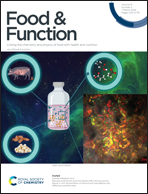Novel kokumi peptides from yeast extract and their taste mechanism via an in silico study†
Abstract
Yeast extract, a widely utilized natural substance in the food industry and biopharmaceutical field, holds significant potential for flavor enhancement. Kokumi peptides within yeast extracts were isolated through ultrafiltration and gel chromatography, followed by identification using liquid chromatography tandem mass spectrometry (LC-MS/MS). Two peptides, IQGFK and EDFFVR, were identified and synthesized using solid-phase methods based on molecular docking outcomes. Sensory evaluations and electronic tongue analyses conducted with chicken broth solutions revealed taste thresholds of 0.12 mmol L−1 for IQGFK and 0.16 mmol L−1 for EDFFVR, respectively, and both peptides exhibited kokumi properties. Additionally, through molecular dynamics simulations, the binding mechanisms between these peptides and the calcium-sensing receptor (CaSR) were explored. The findings indicated stable binding of both peptides to the receptor. IQGFK primarily interacted through electrostatic interactions, with key binding sites including Asp275, Asn102, Pro274, Trp70, Tyr218, and Ser147. EDFFVR mainly engaged via van der Waals energy and polar solvation free energy, with key binding sites being Asp275, Ile416, Pro274, Arg66, Ala298, and Tyr218. This suggests that both peptides can activate the CaSR, thereby inducing kokumi activity. This study provides a theoretical foundation and reference for the screening and identification of kokumi peptides, successfully uncovering two novel kokumi peptides derived from yeast extract.



 Please wait while we load your content...
Please wait while we load your content...